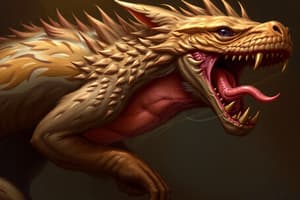Podcast
Questions and Answers
What is biofilm primarily composed of?
What is biofilm primarily composed of?
- Algae, bacteria, fungi, and protozoans (correct)
- Algae and larger aquatic animals
- Only algae and plants
- Only bacteria and fungi
What role do grazers and scrapers play in the aquatic ecosystem?
What role do grazers and scrapers play in the aquatic ecosystem?
- They serve as predators for aquatic insects
- They filter food particles from the water
- They primarily feed on larger fish
- They scrape and feed on biofilm and algae (correct)
What do shredders primarily feed on?
What do shredders primarily feed on?
- Detritus from dead animals
- Live aquatic organisms
- Biofilm and algae
- Vegetation that has fallen into the water (correct)
What distinguishes collector/gatherers from other aquatic insects?
What distinguishes collector/gatherers from other aquatic insects?
Which of the following is a characteristic of filter-feeders?
Which of the following is a characteristic of filter-feeders?
Which group of invertebrates are considered predators in both larval and adult stages?
Which group of invertebrates are considered predators in both larval and adult stages?
How do water boatmen differ from water beetles?
How do water boatmen differ from water beetles?
What type of mouthparts do grazing animals possess to feed on biofilm?
What type of mouthparts do grazing animals possess to feed on biofilm?
Which of the following is NOT a component of biofilm?
Which of the following is NOT a component of biofilm?
What is the primary food source for collector/gatherers?
What is the primary food source for collector/gatherers?
Which of the following animals is NOT a predator in the aquatic ecosystem?
Which of the following animals is NOT a predator in the aquatic ecosystem?
Which of the following organisms contributes to the formation of biofilm?
Which of the following organisms contributes to the formation of biofilm?
Which of these is a characteristic of filter-feeders?
Which of these is a characteristic of filter-feeders?
What role do shredders play in the aquatic ecosystem?
What role do shredders play in the aquatic ecosystem?
What is the main difference between water beetles and water boatmen?
What is the main difference between water beetles and water boatmen?
Which of the following is a characteristic of grazers and scrapers?
Which of the following is a characteristic of grazers and scrapers?
Which of these organisms is NOT directly involved in the breakdown of dead organic matter?
Which of these organisms is NOT directly involved in the breakdown of dead organic matter?
What is the primary function of the protective casing built by caddisfly larva?
What is the primary function of the protective casing built by caddisfly larva?
Flashcards
What is a biofilm?
What is a biofilm?
A complex community of organisms, including algae, bacteria, fungi, and protozoans, that forms a sticky layer on surfaces, such as rocks or aquatic vegetation.
What are grazers and scrapers?
What are grazers and scrapers?
A group of animals that scrape biofilm and algae off surfaces using special mouthparts.
What are shredders?
What are shredders?
Insects that live on the stream bottom and break down leaves and vegetation for food.
What are collector/gatherers?
What are collector/gatherers?
Signup and view all the flashcards
What are filter-feeders?
What are filter-feeders?
Signup and view all the flashcards
What are predators?
What are predators?
Signup and view all the flashcards
What is photosynthesis?
What is photosynthesis?
Signup and view all the flashcards
What is detritus?
What is detritus?
Signup and view all the flashcards
How do algae in biofilms get energy?
How do algae in biofilms get energy?
Signup and view all the flashcards
What are predators in aquatic ecosystems?
What are predators in aquatic ecosystems?
Signup and view all the flashcards
What are examples of aquatic predators?
What are examples of aquatic predators?
Signup and view all the flashcards
How do caddisfly larvae use shredded leaves?
How do caddisfly larvae use shredded leaves?
Signup and view all the flashcards
What happens to predators after they reach adulthood?
What happens to predators after they reach adulthood?
Signup and view all the flashcards
Study Notes
Functional Feeding Groups
- Aquatic insects and macroinvertebrates are categorized into functional feeding groups based on their feeding habits.
- Biofilm: A complex community of algae, bacteria, fungi, and protozoans living in a matrix of secretions. Algae conduct photosynthesis. Bacteria, fungi, and single-celled organisms feed on algae secretions. Detritus and other organic materials in the matrix also provide food. Algae contribute to the reddish-brown substance on rocks.
- Grazers/Scrapers: These animals specialize in feeding on biofilm and algae, scraping it off rocks and vegetation using rasping mouthparts. Examples include caddisfly larvae and freshwater snails. Some caddisflies create protective casings from stones cemented together with silk.
- Shredders: These insects feed on fallen vegetation, ripping and shredding leaves. They use tearing mouthparts and some use shredded leaf pieces to create protective casings, such as caddisfly larvae.
- Collector/Gatherers: These insects primarily scavenge for dead organisms, detritus, or other food particles lodged between rocks or in deep pools. Examples include stonefly larvae, mayfly larvae, and caddisfly larvae.
- Filter-Feeders: These organisms filter out particles from water either by swimming or sitting still and filtering. They often consume pieces of vegetation and detritus dislodged by other organisms. Examples include hydra, amphipods, copepods, and mayfly nymphs. Some filter-feeders are predatory feeding on live organisms that drift in the current.
- Predators: Some invertebrate species are predators in both their larval and adult stages. They consume other aquatic insects, tadpoles, and even small fish. Examples include dragonfly larvae, water beetles (larvae and adults), water striders, and dobsonfly larvae. Water boatmen, though similar to water beetles in behaviour, are actually true bugs. Predators may hunt either in the water or on the water surface.
Studying That Suits You
Use AI to generate personalized quizzes and flashcards to suit your learning preferences.




